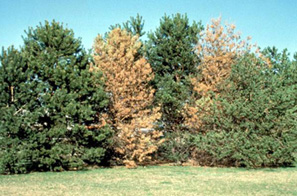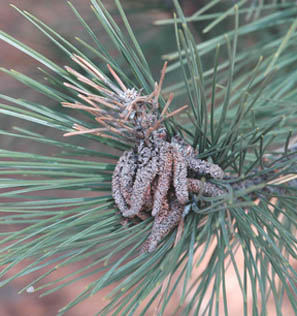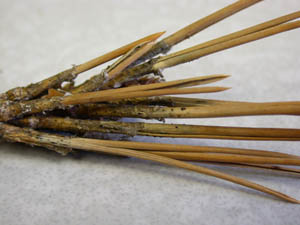Conifer Concerns | |
|---|---|
| September 4, 2008 | |
|
It is often difficult to determine whether a conifer is showing symptoms of infectious diseases or stress from environmental conditions and site imperfections. Possibly the concern is one-sided burn, browning of needle and stem tips, overall yellowing, or possibly worse symptoms. Fortunately, not all conifer problems are due to disease. If the problem appeared in a few days, disease is not likely. If symptoms have become progressively worse over the past months, then plant disease is a possibility. Conifers are usually evergreen. Bald cypress, larch, and dawn redwood are conifers that drop their needles in the autumn, so they arenít evergreen. All the other conifers we grow, such as pine, spruce, fir, and Douglas-fir, hold their needles year-round. It is natural for evergreens to drop third-year needles at some point in the year, usually in autumn, but 1- and 2-year-old needles are not affected. If they are, your tree may have a problem. Many diseases commonly affect conifers in Illinois, including four needle cast diseases, three needle blights, five shoot and twig blights, two stem diseases, five rusts, one wilt disease, and three root rot diseases. Those are only the common diseases. We see others as well, depending on the weather and site stress that might predispose a plant. I have a few suggestions on what you can do to work toward determining the cause of your conifer problems. First, take a step back and examine the big picture. The pattern of affected plants in the landscape or planting block is important to diagnosticians. Most diseases begin in hot spots and slowly spread from those sources. It is rare to see a disease affect a line of trees at once or to appear seemingly overnight. Look at similar trees in the community to see if they also show the symptoms. If all the pines in the area are affected, environmental stress is more likely. Next, determine the pattern on one affected plant. A tree that is yellow or off-color on one entire side suggests a stress on that side of the tree. Salt spray burn in the winter can be seen as one-sided burn on evergreens. On the other hand, if the entire tree declines at once, look at roots or the lower stem as potential sites of problems. You may find that the trunk has been girdled by old nylon twine left at planting, roots have grown around the base of the tree, or a weed trimmer has girdled the trunk. Tip browning over the entire tree might indicate possible root rot, drought stress, flooding injury, mechanical injury, or other factors that could affect roots. Excessive fertilization can also cause browning of stem and needle tips. Gather facts about the site, care of the trees, and especially practices or events that may have changed prior to problem expression. It is helpful to know the plant species to determine possible sensitivities. For example, Scotch pines are very susceptible to pine wilt. The image shows two trees in a group of similarly aged pines that are infected with pine wilt.  The three healthy trees have not yet been infected. Find out whether chemicals have been used on the plant or on nearby plants, and determine timing in relation to symptom expression. Usually chemical injury appears soon after chemicals are applied. Was there a late frost just before tip burn developed on your spruce? One last step is to look for signs of disease or evidence of insect activity. Disease pathogens often form structures that we call fruiting bodies. These structures are usually about the size of a pinhead and are embedded in affected tissue. They donít rub off easily. Diseases such as Diplodia blight on pine or needle cast on spruce have such structures that clinch the diagnosis. The images shows pine needles infected with Diplodia, found at the end of a branch.  The second image shows needles with fruiting bodies embedded in the needles.  Many good Web sites offer information about conifer diseases. An Extension Web site, http://www.urbanext.uiuc.edu/focus/, describes some evergreen tree and shrub problems. Fact sheets about specific diseases can be found at http://www.ag.uiuc.edu/%7Evista/horticul.htm. Plant samples and pictures may be taken to your local Extension office for diagnostic help and possibly diagnosed through University of Illinois Extension Distance Diagnostics through Digital Imaging (DDDI) system, which uses specialists from throughout the state. The University of Illinois Plant Clinic (http://plantclinic.cropsci.uiuc.edu) is another option available from May through mid-September. Early diagnosis is important. Once a positive diagnosis has been made, we can suggest changes in cultural practices, possible spray options, or other ideas to help you manage the problems found on your conifers. | |
| Author: | Nancy Pataky |
